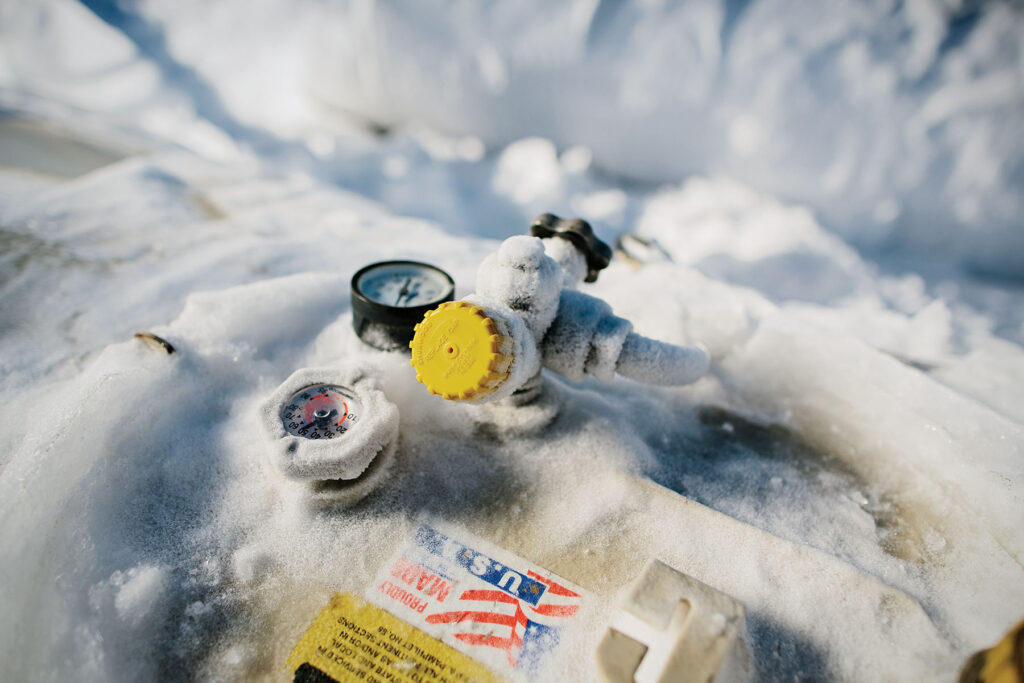Propane Safety For High Snowfall

UNDERSTAND: Your Home’s Propane System
Winters in Connecticut can be some of the most magnificent, but they can also be the most challenging. Accumulated snow and ice have the potential to damage your propane system. While you can’t predict the first snowstorm or hazardous weather condition, with Total Fuel Service you are in the best position to take measures to plan for them.
Get to know your propane system.
If you are not familiar with your propane system, take a few minutes to review it. Identify core components- tank, regulators, meter, piping, and supply valves—as well as any appliance vents. Be sure you know where your gas supply valve is located, in case you need to close it in the event of an emergency. For more information, contact your Total Fuel Service.
PREPARE: Before the First Snowfall
Mark your tank and regulator.
Mark your tank with a brightly colored stake or flag taller than the maximum anticipated snow depth. Also, mark your secondary pressure regulator or meter. It is usually near the side of your home (see photo below at left). Check local ordinances about marking tanks and regulators, and follow any rules applicable to your jurisdiction. It is important to mark your tank and equipment to enable emergency and propane service personnel to locate it at all times.
Have an adequate supply of propane in your tank.
In high snowfall areas, roads leading to your home might not be accessible for delivery, particularly after a snowstorm. It is recommended that you establish a regular delivery schedule with Total Fuel Service.
Talk to your contractors.
If you use a snow removal service, make sure that the service knows the location of all propane equipment on the property. Instruct them to keep their equipment clear of all parts of your propane system. If your snow removal service shovels snow off your roof, instruct them to never shovel snow onto any part of the propane system. Provide a copy of this brochure to your snow removal service.
TAKE ACTION: During & After Snowstorms
Keep snow and ice from accumulating on propane equipment.
Snow or ice accumulation can potentially cause parts of your propane system to crack or break, resulting in a gas leak. It is your responsibility to make sure that all propane pipes, valves, regulators, and tanks are clear of snow and ice. Gently brush away snow or ice that has accumulated around the tank, meter, regulator, and any other piping. Do this using a broom or by hand. If you must use a shovel, use extreme caution around all equipment. If you notice any snow or ice buildup that cannot be removed easily, contact TFS immediately. DO NOT attempt to remove snow or ice by kicking or hitting equipment.
Be alert to snow buildup on rooftops and other areas.
Frequently check where snow or ice collect on your roof, structure, or nearby trees and clear it if you believe it might fall on any part of your propane system. Never shovel snow off roofs and onto propane equipment. Heavy accumulations of snow or ice falling on tanks, regulators, meters, piping, or valves may cause damage that could result in a gas leak.
Keep vents clear.
Appliance vents and chimney flues must ALWAYS be clear of snow or ice. Some homes may have “direct” vents, which are close to the ground. Improper venting can cause carbon monoxide to become trapped in your home, causing serious illness or even death.
Clear driveways and pathways to propane tanks.
Please remember that a propane delivery truck needs at least a 10-foot-wide path to be able to deliver fuel to your home. Also, keep the tank area and a path to the tank free of snow. When plowing, snow blowing, or shoveling, do not push or pile snow around your tank, meter, regulator, or piping.
For more tips answers to your questions, contact Total Fuel Service TODAY!
Source: propane.com
